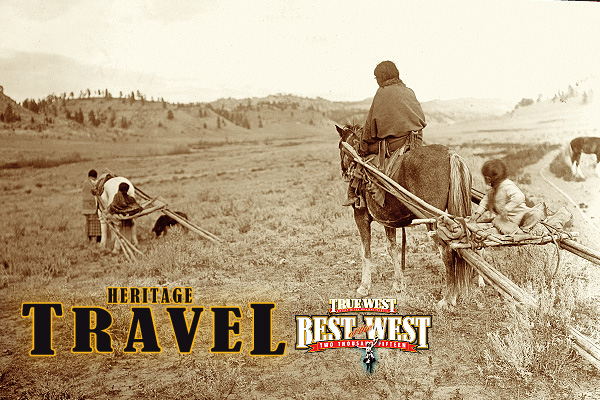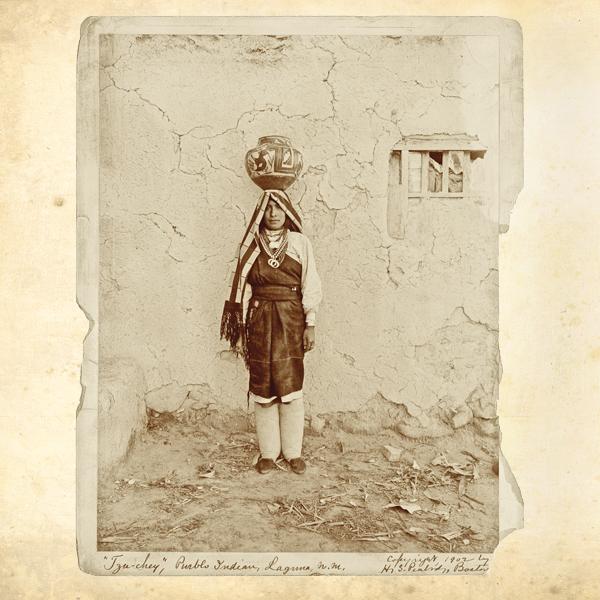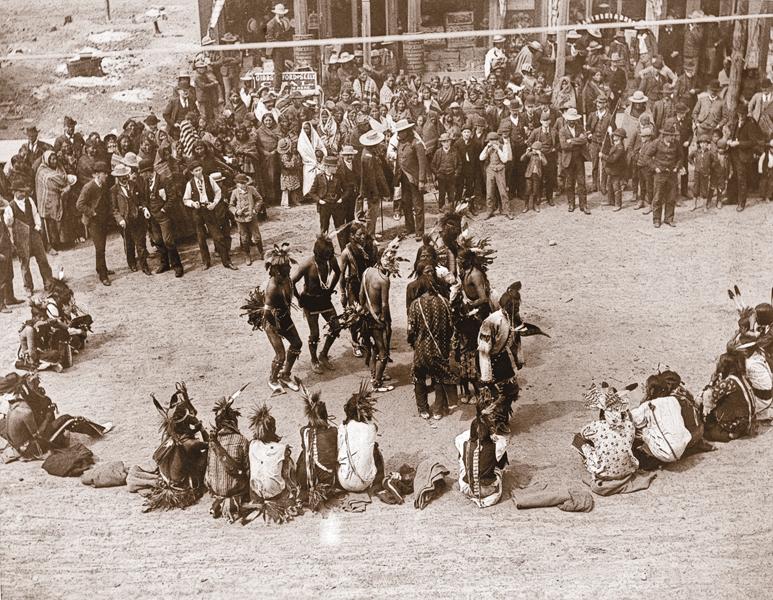 In 1840, trapper Joseph Meek led the first emigrant wagons over the Oregon Trail from Fort Hall to Fort Walla Walla in the Oregon Territory. Today, 175 years later, tourists come to the American West from around the world to follow the Oregon Trail, as well as numerous other historic trails, highways and back roads to discover firsthand the history of the West. While True West magazine provides the best articles and insights on Western travel in every issue, we especially hope that this month, our annual Heritage Travel Guide will inspire you to discover new trails and adventures across the West.
In 1840, trapper Joseph Meek led the first emigrant wagons over the Oregon Trail from Fort Hall to Fort Walla Walla in the Oregon Territory. Today, 175 years later, tourists come to the American West from around the world to follow the Oregon Trail, as well as numerous other historic trails, highways and back roads to discover firsthand the history of the West. While True West magazine provides the best articles and insights on Western travel in every issue, we especially hope that this month, our annual Heritage Travel Guide will inspire you to discover new trails and adventures across the West.
*** BEST OF THE WEST 2015***
BEST PLACE TO LIVE LIKE AN OLD WEST COWBOY
Editor’s Choice: Prescott, AZ
Reader’s Choice: Sheridan, WY
BEST OLD WEST GUNFIGHTER TOWN
Editor’s Choice: Deadwood, SD
Reader’s Choice: Tombstone, AZ
BEST PRESERVED PIONEER TOWN
Editor’s Choice: Stuhr Museum of the Prairie Pioneer, Grand Island, NE
Reader’s choice: Dodge City, KS
BEST OLD WEST ART TOWN
Editor’s Choice: Scottsdale, AZ
Reader’s Choice: Santa Fe, NM
BEST TOWN FOR HISTORICAL ENTERTAINMENT
Editor’s Choice: Durango, CO
Reader’s Choice: Prescott, AZ
BEST ARCHITECTURALLY-PRESERVED WESTERN TOWN
Editor’s Choice: Grass Valley, CA
Reader’s Choice: Deadwood, SD
BEST HISTORICAL TOWN TOUR
Editor’s Choice: Old Sacramento, Sacramento, CA
Reader’s Choice: History Trolley Tours, Dodge City, KS
BEST PROMOTION OF A HISTORICAL PLACE
Editor’s Choice: Lincoln, NM
Reader’s Choice: Dodge City, KS
BEST OLD WEST TOWN TO LIVE IN
Editor’s Choice: Cody, WY
Reader’s Choice: Prescott, AZ
BEST HISTORICAL CEMETERY OF THE WEST
Editor’s Choice: Concordia Cemetery, El Paso, TX
Reader’s Choice: Boot Hill Cemetery, Dodge City, KS
BEST PRESERVED HISTORICAL FORT OF THE WEST
Editor’s Choice: Fort Laramie, WY
Reader’s Choice: Bent’s Old Fort, CO
BEST HISTORICAL RAILROAD OF THE WEST
Editor’s Choice: Durango & Silverton Narrow Gauge Railroad, CO
Reader’s Choice: Cumbres & Toltec Railroad, Chama, NM
BEST PRESERVATION OF A HISTORICAL WESTERN BUILDING
Editor’s Choice: Lincoln County Courthouse, Lincoln, NM
Reader’s Choice: Bird Cage TheatreTombstone, AZ
BEST PRESERVED HISTORICAL TRAIL
Editor’s Choice: Oregon Trail
Reader’s Choice: California Trail
BEST PRESERVATION EFFORT OF THE WEST
Editor’s Choice: Las Vegas, NM
Reader’s Choice: Dodge City, KS
BEST “WHO SLEPT HERE?” HOTEL
Editor’s Choice: Irma Hotel, Cody, WY
Reader’s Choice: Hotel Colorado, Glenwood Springs, CO
BEST HERITAGE HOTEL
Editor’s Choice: Strater Hotel, Durango, CO
Reader’s Choice: Irma Hotel, Cody, WY
BEST HERITAGE BED & BREAKFAST
Editor’s Choice: Grand Canyon Bed & Breakfast, Williams, AZ
Reader’s Choice: Ellis Store Country Inn, Lincoln, NM
BEST HISTORICAL SALOON OF THE WEST
Editor’s Choice: Crystal Palace Saloon, Tombstone, AZ
Reader’s Choice: Occidental Saloon, Buffalo, WY
BEST TREASURE HUNTING DEVICE
Editor’s Choice: Garrett AT Gold, Garrett Metal Detectors, Garland, TX
BEST HISTORICAL RESTAURANT
Editor’s Choice: Buckhorn Exchange, Denver, CO
Reader’s Choice: La Fonda, Santa Fe, NM
BEST CHUCKWAGON COOK-OFF
Editor’s Choice: Lincoln County Cowboy Symposium, Ruidoso, NM
Reader’s Choice: National Cowboy Symposium and Celebration, Lubbock, TX
BEST CHUCKWAGON SHOW & SUPPER
Editor’s Choice: Boot Hill Museum, Long Branch Variety Show, Dodge City, KS
Reader’s Choice: Bar J Wranglers, Jackson Hole, WY
BEST HERITAGE GUEST RANCH
Editor’s Choice: White Stallion Ranch, Tucson, AZ
Reader’s Choice: Flying E Dude Ranch, Wickenburg, AZ
BEST OLD WEST MOUNTED RE-ENACTMENT
Editor’s Choice: Defeat of Jesse James Days, Northfield, MN
Reader’s Choice: Custer’s Last Ride, Little Bighorn Battlefield, MT
BEST OLD WEST RE-ENACTMENT GROUP
Editor’s Choice: Six Guns and Shady Ladies, El Paso, TX
Reader’s Choice: Prescott Regulators and Their Shady Ladies, Prescott, AZ
BEST WILD WEST SHOW
Editor’s Choice: Wild Western Festival, Glendale, AZ
Reader’s Choice: Western Legends Roundup, Kanab, UT
BEST COWBOY POETRY GATHERING
Editor’s Choice: National Cowboy Poetry Gathering, Elko, NV
Reader’s Choice: National Cowboy Symposium & Celebration, Lubbock, TX
BEST COWBOY MUSIC GATHERING
Editor’s Choice: Santa Clarita Cowboy Festival, Santa Clarita, CA
Reader’s Choice: Spirit of the West Cowboy Gathering, Ellensburg WA
Photo Gallery
During an 1898 Snake Dance, tourists watched Antelope priest Nihapooma remove a natchi, a ceremonial bow fastened with skins of the weasel, from a ladder in an Antelope kiva in the Hopi village of Walpi, Arizona. George Wharton James, who took this photo, wrote that, just like the weasel works himself out of a hole after being chased into another hole, the Hopi were praying for clouds to come out so rain would fall.
– Courtesy Library of Congress –
– True West Archives –
Born in 1859, spiritual healer Bear Bull had left Canada to visit his Blackfoot tribal brothers, the Southern Piegan, in Montana, in 1899. Edward S. Curtis photographed the man at the Sun Dance, and that is possibly when he captured this image of Bear Bull in front of a tipi.
– Courtesy Library of Congress –
During his visit to the Tewa pueblos in New Mexico, photographer Edward S. Curtis learned of the Buffalo Dance, celebrated in January. Painted black above the waist and wearing a hat of buffalo hair and horns, the dancers, he wrote, portrayed the “actions of the buffalo, hunted, stampeding, charging, drooping with exhaustion, reviving for another effort to escape….”
– Courtesy Library of Congress –
In 1871, Lt. George M. Wheeler led the “first and only” boat expedition to ascend the Colorado River through the Grand Canyon to the mouth of Diamond Creek, as the stereograph caption states. Timothy H. O’Sullivan photographed Mohaves and explorers leaving the dock from Arizona’s Camp Mohave for the 260-mile, 31-day journey.
– Courtesy Library of Congress –
Navajos at Cañon del Muerto, 1908, is an Edward S. Curtis photograph among others on rotation at Tucson’s Arizona State Museum through July 18, 2015. A prehistoric Indian burial ground was found here in 1882; the canyon is now part of Canyon de Chelly National Monument in Chinle.
– Courtesy Arizona State Museum’s “Curtis Reframed” exhibit, now through July 18, 2015 –
“Captain” John Spencer, an Owens Valley Paiute in Bishop, California, photographed by Andrew A. Forbes in 1903. Spencer was the village head in charge of organizing the tribe’s annual dress. He wears the dance regalia—an eagle down crown and a kilt with strands of eagle down, tipped with hawk and magpie feathers. On his chest are tufts of cotton stuck on with pine pitch.
– Courtesy Library of Congress –
With his gunbelt, rifle and stuffed beaver pelt, this Warm Springs Apache came to be known as Chah—Apache for “beaver”— due to this 1885 photo by Ben Wittick.
– Courtesy Library of Congress –
Whenever food became difficult to obtain, the Cheyennes, like many Plains Indians, would move camp. Women carried babies on their backs and lashed bundles of belongings onto travois poles hung from horses. As George Bird Grinnell recounted in The Cheyenne Indians, little girls would mimic their mothers by hitching dogs to a travois. These dogs were valuable pack animals in the pre-horse era.
– True West archives –
In 1870, William Henry Jackson took photographs of Shoshone Chief Washakie’s camp along the Sweetwater River, near Wyoming’s Camp Stambaugh. His photos of the tipi village at South Pass are among the earliest taken prior to reservation.
– True West Archives –
The Colville Indian Reservation agency physician since 1890, Edward Latham took up residence in Nespelem, Washington, and took hundreds of photographs of reservation Indians, including this one of Coolcoolaweela, an Okanagan man clothed in ceremonial garb.
– True West Archives –
Someone has hand colored this circa 1885 photograph taken by David F. Barry. Curly, a Crow scout who assisted George Custer during the Sioux Wars, wears the traditional fur-wrapped braids and tiered shell necklace with a trade shirt.
– True West Archives –
Edward S. Curtis first visited the Piegan in their Montana camp during the summer of 1898. He labeled this 1910 photo of a Piegan woman “Day-Dreams.” With only about a few hundred left at the time of his visit, she may have been thinking of when her people were proud hunters who roamed a vast domain.
– Courtesy Library of Congress –
Robert W. Larson won the Spur award for his biography of Gall, which laid to rest the contention that the Lakota war chief was “Custer’s conqueror” at the disastrous 1876 Battle of the Little Big Horn. Interestingly, George Custer’s wife, Libby, upon viewing a photograph of Gall, exclaimed she never “dreamed there could be…so fine a specimen of warrior.”
– Courtesy Robert G. McCubbin collection –
The Miniconjou Lakota tribe formerly inhabited a region in South Dakota that stretched from the Black Hills to the Platte River. In 1890, John Grabill photographed Big Foot’s band at a Grass Dance along the Cheyenne River. By the end of the year, Chief Big Foot, also called Spotted Elk, was killed by the 7th Cavalry at Wounded Knee.
– Courtesy Library of Congress –
Tzuchey, also known as Minnie Sice, was an English-speaking, Carlisle-educated Pueblo woman living in Laguna, New Mexico. She stands with a duonne (water jar). Her pottery was the first to receive a glaze, taught by Josephine Foard after her 1899 arrival, which began a trend in crafting waterproof pots more acceptable for Easterners with their wooden floors. Henry G. Peabody photographed Tzuchey, circa 1902.
– Courtesy Library of Congress –
To stop Apache raids in Mexico, the U.S. government moved the Chiricahua to San Carlos. Despite his age (he was reportedly 80 when he raided New Mexico in 1881), Nana had the tenacity and courage to join Geronimo, Victorio and other leaders in bolting the Arizona reservation to continue their onslaughts. Nana is shown in a photograph attributed to Ben Wittick, believed to have been taken in 1886, when Nana finally surrendered to Gen. George Crook.
– Courtesy Robert G. MCCubbin collection –
Representing Buffalo Bill Cody’s Wild West show, these 11 fully-costumed Indians, including one dressed as a scout, stand on the rocks at Land’s End, England, on May 29, 1904.
– True West Archives –
Intertribal visits during the early reservation period resulted in the Omahas passing down their dance to the Lakota around 1865. By the summer of 1881, the Cheyenne and Kiowa tribes were performing the Omaha dance. Ten years later, the Wiley brothers documented the Cheyennes’ Omaha powwow in Miles City, Montana.
– Courtesy Library of Congress –
Discovered in a glass plate negative collection owned by Ben Fish, of Iowa Park, Texas, this photo of the last Quahada Comanche chief, Quanah Parker, may have been taken by William E. Irwin. The collection included a known Irwin photograph of Quanah with two of his seven wives, circa 1890.
– True West archives –
At the age of nine, Quanah Parker, the eldest of Comanche father Peta Nocona and white mother Cynthia Parker’s three children, lost his mother when she was taken by the Texas Rangers in 1860. In 1884, Quanah ran a newspaper advertisement in search of a photo of his mother, who had died before he could reunite with her. A.F. Corning, who took a daguerreotype of Cynthia with Quanah’s sister in 1862, responded. Quanah, at last, had a photo of his mother.
– Courtesy Cowan’s Auctions, December 9, 2009 –
Following the Kiowas’ 1868 removal to a reservation at Oklahoma’s Fort Sill, Satank and his followers killed the wagon master and six teamsters during an 1871 raid on a wagon train in Texas. Satank was approximately 71 years old then, a year older than when William Soule photographed him in 1870. On his way to court to stand trial in Texas, he was shot to death after stabbing a guard.
– Courtesy Robert G. McCubbin collection –
Carrying bows and arrows, these two Apache Hunters were photographed in 1888 by A. Frank Randall. The hunter at far left doesn’t have foot gear as nice as his partner’s; he wears what looks to be U.S. Army-issued socks.
– Courtesy Smithsonian Institute Bureau of American Ethnology –





























